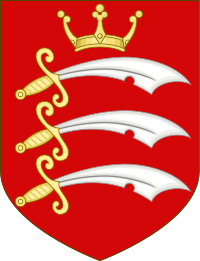1795, Great Britain, Middlesex. Cu "Princess of Wales" ½ Penny Token. PCGS MS64!


Mint Year: 1795
Reference: D&H-977.
Denomination: 1/2 Penny Token
Condition: Certified and graded by PCGS as MS-64 BN! - Top Pop 4/0!
Weight: ca. 10.5gm
Material: Copper
Diameter: 29mm
Obverse: Female draped bust facing 3/4 left, wearing peral-jewellery.
Legend: PRINCESS OF WALES .
Reverse: Crest of the Princes of Wales (plummed crown) above crest of the House of Beaufort (portcullis). Date (1795) below and value (HALF-PENNY) at sides.

The portcullis was the heraldic badge of the House of Beaufort, and the first Tudor king, Henry VII, who was of matrilineal Beaufort descent, adapted both the portcullis and the Tudor rose into Royal badges of the House of Tudor. Since then, the portcullis has been a moderately common motif of English heraldry, especially that heraldry dating from the Tudor period. The heraldic office of Portcullis Pursuivant of Arms in Ordinary, a junior officer of arms in the College of Arms at London, dates from this period.
The Prince of Wales is the title traditionally given to the heir apparent to the reigning monarch of the United Kingdom. It originated as the title of independent princes of Wales in the 12th and 13th centuries.

Authenticity unconditionally guaranteed. Bid with confidence!
 Middlesex (/ˈmɪdəlsɛks/; abbreviation: Middx) is a historic county in southeast England. Its area is almost entirely within the wider urbanised area of London and mostly within the ceremonial county of Greater London, with small sections in neighbouring ceremonial counties.
Middlesex (/ˈmɪdəlsɛks/; abbreviation: Middx) is a historic county in southeast England. Its area is almost entirely within the wider urbanised area of London and mostly within the ceremonial county of Greater London, with small sections in neighbouring ceremonial counties.
The county's name derives from its origin as the Middle Saxon Province of the Anglo-Saxon Kingdom of Essex, with the county of Middlesex subsequently formed from part of that territory in either the ninth or tenth century, and remaining an administrative unit until 1965. The county is the second smallest, after Rutland, of the historic counties of England.
Three rivers provide most of the county's boundaries; the Thames in the south, the Lea to the east and the Colne to the west. A line of hills forms the northern boundary with Hertfordshire. The largely low-lying county is dominated by clay in its north and alluvium on gravel in its south.
The City of London was a county corporate from the 12th century and was able to exert political control over Middlesex. To the east of the City, the Tower Division (or Tower Hamlets) had considerable autonomy under its own Lord Lieutenant. As London expanded into rural Middlesex, the Corporation of London resisted attempts to expand the city boundaries into the county, which posed problems for the administration of local government and justice. In the 18th and 19th centuries, the population density was especially high in the southeast of the county, including the East End and West End of London. From 1855, the southeast was administered, with sections of Kent and Surrey, as part of the area of the Metropolitan Board of Works. When county councils were introduced in England in 1889 about 20% of the area of the historic county of Middlesex, along with a third of its population, was incorporated into the new administrative County of London and the remainder incorporated into the administrative county of Middlesex, governed by the Middlesex County Council that met regularly at the Middlesex Guildhall in Westminster. The City of London, and Middlesex, became separate counties for other purposes and Middlesex regained the right to appoint its own sheriff, lost in 1199.[citation needed]
In the interwar years, suburban London expanded further, with improvement and expansion of public transport, and the setting up of new industries. After the Second World War, the populations of the administrative county of London and of inner Middlesex were in steady decline, with high population growth continuing in the outer parts of Middlesex. After a Royal Commission on Local Government in Greater London, almost all of the area of the historic county of Middlesex was incorporated into Greater London in 1965, with the rest included in neighbouring ceremonial counties.
Only 1$ shipping on each additional item purchased!